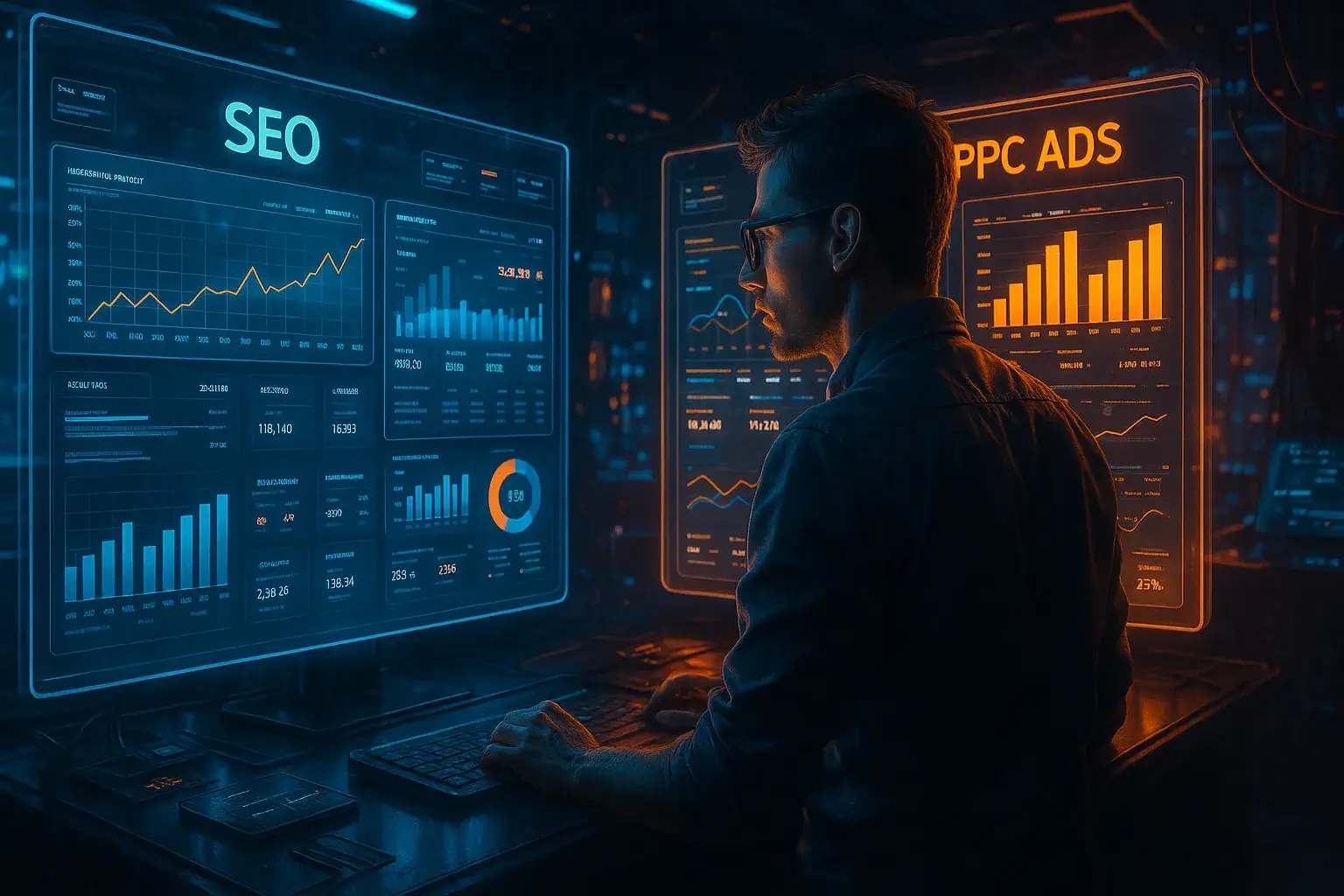SEO vs PPC in 2025: Which Strategy Delivers Higher ROI?
title: 'SEO vs PPC in 2025: Which Strategy Delivers Higher ROI?' date: '2025-09-11T09:30:00-07:00' description: 'A deep dive into SEO vs PPC in 2025, exploring ROI, costs, and growth strategy for brands seeking sustainable digital marketing success.' tags: [ 'SEO vs PPC 2025', 'SEO vs PPC ROI comparison', 'SEO vs PPC cost analysis', 'paid search vs organic traffic', 'digital marketing ROI strategies', 'search marketing trends 2025', 'SEO vs PPC for small business', 'long-term SEO vs short-term PPC', 'SEO vs SEM differences', 'which is better SEO or PPC', ] image: '/posts/post-4-1.webp' status: 'published'
In 2025, digital marketers face a critical decision: invest in Search Engine Optimization (SEO) for compounding organic growth, or in Pay-Per-Click (PPC) advertising for immediate results. Both tactics deliver visibility, but their ROI profiles differ greatly. Understanding these nuances can determine whether a campaign drives long-term profitability or consumes budget without impact.

The State of Search Marketing in 2025
AI-driven search, Googleapos;s Search Generative Experience (SGE), and voice-first interfaces have shifted user behavior. Winning businesses now need hybrid strategies that merge organic growth through authoritative content with precise, AI-powered ad targeting.
- SEO leans heavily on authority building, topic clustering, and entity-based semantic relevance.
- PPC thrives on predictive targeting, algorithmic bidding, and real-time personalization.
The challenge marketers face is not simply which channel works, but which channel delivers higher ROI for their specific model.
How We Define ROI in 2025
ROI in marketing is calculated beyond a basic revenue-to-cost ratio. In 2025, smart marketers consider:
- Customer Acquisition Cost (CAC)
- Customer Lifetime Value (CLV)
- Attribution modeling in multi-device, multi-touch journeys
- Opportunity cost between instant versus compounding gains
This makes the SEO vs PPC debate less about short-term profit and more about sustainable growth trajectories.
SEO ROI in 2025
Strengths
- Compounding traffic value: Once ranking is secured, the clicks keep coming at near-zero marginal cost.
- Trust factor: Organic listings attract more trust, especially in health, SaaS, and B2B niches.
- Content reach: SEO captures multiple layers of intent (informational, commercial, transactional).
Weaknesses
- Delayed ROI: Ranking takes months.
- Vulnerability to updates: Algorithm volatility can erode gains overnight.
- Resource heavy: Content + links require ongoing investment.
Case Example: A SaaS firm invests $60,000 in SEO within year one. By month twelve, organic search generates traffic equal to $25,000/month in paid ad equivalent, leading to exponential ROI over two years.
PPC ROI in 2025
Strengths
- Immediate traction: Campaigns can drive revenue in days.
- High precision: Predictive audience segmentation ensures spend efficiency.
- Scalable: Budget in, leads out—as long as margins remain sustainable.
Weaknesses
- Rising CPCs: Finance, legal, and e-commerce see record ad inflation in 2025.
- Trust deficit: 60% of users skip ads if organic alternatives exist.
- Ephemeral results: Turn off spend, traffic vanishes.
Case Example: An e-commerce brand spends $100,000 on PPC across one season, achieving 3x ROAS. Sales spike immediately, but results vanish once budgets pause.
Cost Structure Comparison
| Factor | SEO | PPC |
|---|---|---|
| Initial Investment | High (content + technical) | Flexible (any budget) |
| Ongoing Cost | Moderate (maintenance, updates) | High (constant ad spend) |
| Break-Even Timeline | 6–12 months | Days to weeks |
| Scalability | Compounding growth | Spend-dependent |
| Main Risks | Googleapos;s updates, content saturation | CPC inflation, ad fatigue |
Industry ROI Trends
Recent reports confirm that SEO dominates B2B ROI, while consumer-facing retail favors PPC:
- 63% of B2B CMOs rank SEO as their top-performing channel for ROI.
- 71% of DTC brands report that PPC remains their revenue driver.
The takeaway: Your vertical shapes your ROI outcomes far more than the channel itself.
The Hybrid Model (SEO + PPC Synergy)
Forward-thinking brands stop treating SEO vs PPC as a rivalry. Instead, they integrate both:
- Feedback loop: PPC keyword conversion data informs SEO keyword targeting.
- SERP dominance: Own ads + organic spots for maximum credibility.
- Budget distribution: Allocate ~60% to SEO for future-proofing, 40% to PPC for instant traction.
New Forces Influencing ROI
- Search Generative Experience (SGE) reshapes CTRs—SEO content must now optimize for generative summaries.
- Cookie deprecation reduces PPC precision, shifting reliance to first-party data.
- Ethical marketing: Audiences prefer trusted organic brands over intrusive ads, boosting SEO ROI further.
Final Verdict
- SEO wins on long-term ROI for businesses prioritizing sustainable growth and authority.
- PPC wins on short-term ROI for brands needing immediate leads and testing flexibility.
- Together, they compound ROI and shield a business from platform volatility.
In 2025, the smartest play is not choosing one, but engineering a hybrid acquisition strategy where SEO builds the foundation and PPC fuels acceleration.
Key Takeaways
- SEO = trust-driven, sustainable compounding growth
- PPC = instant visibility, scalable paid channel
- Synergy = the real ROI multiplier in 2025
Next Steps for Marketers
Ask yourself:
- Do you need immediate traction or sustainable growth?
- Is your budget flexible for continuous ad spend or better invested in assets that compound?
- How much risk can you absorb from Googlealgo changes versus PPC cost surges?
Only by weighing these trade-offs can you customize a winning ROI strategy.